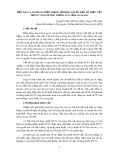
STUD Y PRO T O C O L Open Access
REFOCUS Trial: protocol for a cluster randomised
controlled trial of a pro-recovery intervention
within community based mental health teams
Mike Slade
*
, Victoria Bird, Clair Le Boutillier, Julie Williams, Paul McCrone and Mary Leamy
Abstract
Background: There is a consensus about the importance of ‘recovery’in mental health services, but the evidence
base is limited.
Methods/Design: A two centre, cluster randomised controlled trial. Participants are community-based mental health
teams, and service users aged 18-65 years with a primary clinical diagnosis of psychosis. In relation to the REFOCUS
Manual researchintorecovery.com/refocus, which describes a 12-month, pro-recovery intervention based on the
REFOCUS Model, the objectives are: (1) To establish the effectiveness of the intervention described in the REFOCUS
Manual; (2) To validate the REFOCUS Model; (3) To establish and optimise trial parameters for the REFOCUS Manual;
and (4) To understand the relationship between clinical outcomes and recovery outcomes. The hypothesis for the
main study is that service users in the intervention arm will experience significantly greater increases in measures of
personal recovery (as measured by the QPR) compared to service users receiving care from control teams. The
hypothesis for the secondary study is that black service users in the intervention arm will experience significantly
greater increases in measures of personal recovery (as measured by the QPR) and client satisfaction (as measured by
the CSQ) compared to Black service users receiving care from control teams.
The intervention comprises treatment as usual plus two components: recovery-promoting relationships and working
practices. The control condition is treatment as usual. The primary outcme is the Process of Recovery Questionnaire
(QPR). Secondary outcomes are satisfaction, Goal setting - Personal Primary Outcome, hope, well-being, empowerment,
and quality of life. Primary outcomes for the secondary study will be QPR and satisfaction. Cost data will be estimated,
and clinical outcomes will also be reported (symptomatology, need, social disability, functioning).
29 teams (15 intervention and 14 control) will be randomised. Within each team, 15 services users will be randomly
chosen, giving a total sample of 435 service users (225 in intervention and 210 in control). Power for the main study: 336
service users will give power to detect a medium effect size of 0.4 (alpha 0.05, power = 0.8) on both QPR sub-scales.
Power for the secondary study: 89 participants will give power to detect an effect size of 0.67 on both QPR sub-scales
and on CSQ. A range of approaches are used to minimise bias, although service users and clinicians cannot be blinded.
Discussion: This cluster-RCT will evaluate a pro-recovery intervention in community mental health teams.
Trial registration: ISRCTN: ISRCTN02507940
1. Background
There is a policy and professional consensus about the
importance of ‘recovery’in mental health services, defined
as “a way of living a satisfying, hopeful, and contributing
life”even with any limitations caused by illness [1-4]. This
has recently been elaborated: “Recovery is the process of
regaining active control over one’slife.Thismayinvolve
discovering (or rediscovering) a positive sense of self,
accepting and coping with the reality of any ongoing dis-
tress or disability, finding meaning in one’s experience,
resolving personal, social or relationship issues that may
contribute to one’s mental health difficulties, taking on
satisfying and meaningful social roles and calling on for-
mal and/or informal systems of support as needed”[5].
* Correspondence: mike.slade@kcl.ac.uk
King’s College London, Health Service and Population Research Department,
Institute of Psychiatry, Denmark Hill, London, SE5 8AF, UK
Slade et al.BMC Psychiatry 2011, 11:185
http://www.biomedcentral.com/1471-244X/11/185
© 2011 Slade et al; licensee BioMed Central Ltd. This is an Open Access article distributed under the terms of the Creative Commons
Attribution License (http://creativecommons.org/licenses/by/2.0), which permits unrestricted use, distribution, and reproduction in
any medium, provided the original work is properly cited.

The REFOCUS Study is a research programme funded
through the National Institute for Health Research Pro-
gramme Grants for Applied Research scheme (RP-PG-
0707-10040). The REFOCUS Trial is part of the REFOCUS
Study. The REFOCUS Trial is evaluating an intervention
(described in the REFOCUS manual [6]) based on the
REFOCUS Model, which is derived from wider research
[7] and specifically informed by a systematic review and
narrative synthesis of personal recovery [8]. The REFOCUS
Model is shown in Figure 1.
There is a robust evidence base, including several sys-
tematic reviews, for the key elements of the intervention,
including the contribution of coaching [9,10], values
[11,12], strengths [13,14] and goal-striving [15,16]. This is
the first intervention to evaluate their combined use in a
complex intervention in adult community mental health
services in the NHS in England. The intervention is based
on systematic reviews [8] and international best practice
[17], and informed by research into staff-service user rela-
tionships [18,19] and stigma [20]. Evaluation of the inter-
vention is particularly timely given the current emphasis
on recovery and the associated concept of well-being [21]
in English mental health services. The results of the trial
will be of relevance to (a) developing mental health policy
and associated clinical guidelines; (b) clinical practice.
The experiences of recovery of individuals from minority
ethnic backgrounds have been insufficiently researched, so
a secondary study is being conducted to examine trial out-
comes for participants from black backgrounds.
Understanding the relationship between clinical and
recovery outcomes is vital if debates about the future
direction of mental health services are to be informed by
evidence. These debates are happening [22], and the
empirical evidence base is very limited [23]. This study
will address this knowledge gap.
2. Methods/design
Objectives and hypotheses
The REFOCUS Trial has four objectives
Objective 1: To establish the effectiveness of the
intervention described in the REFOCUS manual,
using outcome evaluation to demonstrate that service
users receiving care from intervention teams make more
progress towards their personal recovery than those
receiving care from control teams. The primary outcome
measure (QPR) and the secondary outcome measures
are listed in Section 13. All outcomes pertain to the
individual level and include both staff and service user
outcomes.
Main study hypothesis: Service users in the interven-
tion arm will experience significantly greater increases
in measures of personal recovery (as measured by the
QPR) compared to service users receiving care from
control teams.
Secondary study hypothesis: Black service users in the
intervention arm will experience significantly greater
increases in measures of personal recovery (as measured
by the QPR) and client satisfaction (as measured by the
CSQ) compared to Black service users receiving care from
control teams.
Objective 2: To validate the REFOCUS Model,
using process evaluation to investigate the extent to
which the intended consequences of the intervention
are predicted by the REFOCUS Model.
Objective 3: To establish and optimise trial para-
meters for the REFOCUS Manual, including recruitment
and retention issues, fidelity, outcome and economic eva-
luation, implementation strategies, missing data analysis,
and sample size calculation
Objective 4: To understand the relationship
between clinical outcomes and recovery outcomes
comprising recovery outcomes of hope, empowerment,
well-being, quality of life and personal recovery, and clin-
ical outcomes of symptomatology, needs and social
disability.
Design
This is a two centre cluster-randomised controlled trial,
with paired teams randomised to receive the intervention
or standard care/treatment as usual arms of the trial. The
recovery intervention will be delivered by all members of
staff who provide a clinical input to the team.
The intervention will be provided to a complete team,
using implementation strategies to support individual
practitioners to introduce and maintain these changes. To
minimise contamination, the unit of randomisation and
analysis is the mental health team. To understand the
impact of the intervention a process evaluation will be
undertaken.
Ethics and trial registration
Ethical approval was obtained from East London REC 3
approval 11/LO/0083 on 22.2.11. The trial registration
number is ISRCTN02507940 http://www.controlled-trials.
com/isrctn.
Study setting
The intervention will be evaluated in two Mental Health
Trusts: South London and Maudsley NHS Foundation
Trust (SLaM) and
2
gether Partnership NHS Foundation
Trust in Gloucestershire.
SLaM is the largest mental health Trust in the UK, has
an annual income of £330 m, spent across over 100 sites
spanning urban and suburban settings. It employs 4,500
staff in 296 teams, works with 34,128 service users, and
provide adult mental health services across four Boroughs
(Croydon, Lambeth, Lewisham, Southwark). These ser-
vices are provided through Clinical Academic Groups
Slade et al.BMC Psychiatry 2011, 11:185
http://www.biomedcentral.com/1471-244X/11/185
Page 2 of 13

(CAGs). CAGs bring together clinical services, research,
education and training for the benefit of patient care. Peo-
ple who use SLaM services are ethnically diverse, with
37% of people using SLaM services recorded on the
clinical information system as coming from a ‘Black Afri-
can’,‘Black Caribbean’or ‘Black other’background.
2
gether is a rural/semi-rural Trust, employing 806 staff
in 23 adult mental health teams, and working with 4,301
Figure 1 The REFOCUS Model.
Slade et al.BMC Psychiatry 2011, 11:185
http://www.biomedcentral.com/1471-244X/11/185
Page 3 of 13

service users. People who use
2
gether services are ethni-
cally homogenous, with a very small number of black
individuals using services. Therefore the secondary study
will be conducted in SLaM only.
Sample
Team inclusion criteria
•Adult, community-based mental health team (due to
the diversity in in-patient provision [24,25])
•Any Complex Care or Promoting Recovery team in
the SLaM Psychosis Clinical Academic Group (CAG) or
any in
2
gether
•Provide a care co-ordinating function
Service user inclusion criteria
•Aged 18-65 years
•Primary clinical diagnosis ofpsychosis,e.g.schizo-
phrenia, schizo-affective disorder, bipolar disorder
•No immediate plans for discharge or transfer
•Not currently receiving in-patient care or in prison
•Speaks and understands English
•Not participating in substantial other study
•Has participating paired staff
•In opinion of clinician, is sufficiently well to
participate
•In regular contact with at least one worker in the
team
Service user exclusion criteria
•Service users who are unable to give consent or are
too unwell to be interviewed (in the opinion of clinician)
•No participating paired staff
•Service user whereabouts unknown or service user is
uncontactable
Additional service user inclusion criteria for secondary
study
•From black African, black Caribbean, black British
or black other backgrounds
Staff inclusion criteria
•Provides clinical input into a team included in the
trial
•Does not also provide clinical input into a team allo-
cated to the opposite arm of the trial.
•In addition, paired staff completing staff-rated ser-
vice user measures are in regular clinical contact with
service users who are recruited into the trial.
Sample size
Main study
The primary outcome is the Process of Recovery Question-
naire(QPR)[26].Thismeasurewaschosenastheonlyser-
vice user-rated measure of personal recovery which has
been developed in England and with adequate psycho-
metric properties (described in Section 13.2). Since perso-
nal recovery is something experienced rather than assessed
by an expert, a self-report measure was appropriate for
clinical end-point. The timing between baseline and fol-
low-up (i.e. the length of the intervention) was chosen as
12 months to allow sufficient time for team-level changes
in practice to occur, be sustained, and have an impact.
The QPR has two sub-scales: intrapersonal (mean =
45.7, sd = 16.1, range 13-68) and interpersonal (mean =
14.0, sd = 3.7, 0-20). The sample size calculation is based
on being able to detect a medium standardised effect size
of 0.4 in both sub-scales, which equates to a difference of
6.4 points on the QPR intrapersonal subscale and 1.5
points on the interpersonal subscale.
The estimated sample size for a two-group comparison
of means (alpha = 0.05, power = 0.8) is 99 per group.
However, as this is a team-level intervention, the unit of
randomisation is the team. An initial 29 teams (20 from
SLaM, 9 from
2
gether) will be recruited, and we anticipate
17% attrition (due to team mergers or restructuring), giv-
ingatotalof24teams(16fromSLaM,8from
2
gether).
The same number of participants will be included from
each team. Adjustment for clustering within teams
assumes an intracluster correlation of 0.05, with equal
numbers of clusters in each randomisation group. For 24
teams, 164 participants are needed per group, i.e. 14 parti-
cipants per team. To allow for one participant (7%) drop-
out per team, 15 participants per team will be recruited
from the 29 teams. This drop-out rate is consistent with
attrition in previous randomised controlled trials we have
conducted [27].
The total initial sample is therefore 435 service users,
comprising 225 in intervention and 210 in control. Based
on the above attrition and clustering estimates, we antici-
pate this will produce an analysable sample of 336 parti-
cipants, giving power to detect a medium effect size of
0.4 (alpha 0.05, power = 0.8) on both QPR sub-scales.
Secondary study
In a pre-planned sub-group analysis, we will also be inves-
tigating the outcomes of service users from black back-
grounds in the SLAM site only. The primary outcomes for
this sub-study will be the QPR (as above) and the Client
Satisfaction Questionnaire - 8 item version (CSQ) [28],
which produces a global satisfaction score (mean = 24, sd
= 6) within this population. CSQ data were available from
a previous study [29], from which a retrospective analysis
of data from black individuals demonstrated an effect size
of 0.67 for differences in CSQ between intervention and
control groups. The sample size calculation for the sec-
ondary study is based on being able to detect a large effect
size of 0.67, equating to a difference of 10.8 on the QPR
intrapersonal subscale, 2.5 on the QPR interpersonal sub-
scale, and 4 on the CSQ.
Using the same estimates for a two-group comparison
of means as for the main study (20% SLaM team attri-
tion, 7% participant attrition, 0.05 intra-cluster correla-
tion, alpha 0.05, power 0.8), 6 participants per team will
Slade et al.BMC Psychiatry 2011, 11:185
http://www.biomedcentral.com/1471-244X/11/185
Page 4 of 13

be recruited. The initial sample of 120 (20 teams × 6
participants) is anticipated to produce an analysable
sample of 89 participants, giving power to detect an
effect size of 0.67 on both QPR sub-scales and on CSQ.
Recruitment and randomisation procedures
Teams will be recruited into the trial over a 12 month per-
iod, at a rate of 5-6 SLaM teams every three months and
4-5
2
gether teams every five months. One of the aims of
this trial is to establish whether this planned recruitment
rate is feasible. The service user baseline assessment mea-
sures are anticipated to take up to 90 minutes, so if neces-
sary will be completed in two face to face meetings with
researchers. The generic staff baseline assessment will take
up to 20 minutes and the paired staff baseline assessment
measures will take an additional 20 minutes per service
user. They will either be completed at the community
base or within the service user’s own home, at a mutually
agreed time.
Participating teams will be randomly allocated on an
equal basis to intervention (N = 15) and control groups (N
= 14). Allocation will be stratified by site (six sites: four
SLaM Boroughs, two
2
gether localities) to ensure balance.
Randomisation will be undertaken using processes set out
by the independent Mental Health and Neuroscience Clin-
ical Trials Unit, on the basis of a team identification num-
ber and site information. Service users will be allocated
based on these clusters.
The clinical information system will be accessed by
either Clinical Studies Officers (CSOs) from National
Institute for Health Research (NIHR) Mental Health
Research Network (MHRN), information analysts or the
researchers acting under arrangements with the responsi-
ble Trust to compile the list of names, diagnoses, ethni-
city and date of births for randomisation. This will be the
only access to clinical information by the research team
prior to consent.
In
2
gether, a randomly ordered list of service users on
the caseload of each team with a clinical diagnosis of psy-
chosis will be generated using the same procedures as set
out by the Clinical Trials Unit. The first 15 service users
will be selected from the randomly ordered caseload list.
In SLaM, two randomly ordered lists of service users
with a psychosis diagnosis on the caseload of the team
will be generated using a random number table. One list
(List A) will comprise service users who come from ser-
vice users who are from black African, black Caribbean
and black other backgrounds, and the other list (List B)
will comprise all other service users. The first 6 service
usersfromlistAandthefirst9fromlistBwillbe
selected, giving a total sample of 15 per SLaM team. This
will ensure epidemiological representativeness in the
sample in relation to black ethnicity, and will ensure suf-
ficient power to test the secondary study hypothesis.
If an individual does not meet inclusion criteria or
refuses consent to participate, then the next person from
the appropriate randomly-ordered list will be chosen.
Caseload randomisation will be undertaken using proce-
dures set out by the Mental Health and Neuroscience
Clinical Trials Unit, on the basis of a service user identifi-
cation number.
Approaches to minimise bias
Due to the nature of the intervention, neither clinicians
nor service users can be blinded to allocation status.
However, several approaches have been used to mini-
mise bias.
Addressing bias at allocation
1. All randomisation will be undertaken by the research
team following procedures set out by the independent
Clinical Trials Unit which has been awarded full CTU
registration by UKCRC. Identifying information about
teams or service users will not be known before
randomisation.
Addressing bias in baseline data
2. Baseline data from staff and service users will as far
as feasible be collected before allocation, to avoid bias
based on allocation status
Addressing bias in the intervention
3. The research team will monitor implementation
across sites, in order to maximise fidelity and ensure
comparability of the intervention between sites.
4. Change in staff for each team will be carefully moni-
tored, with particular attention paid to identifying staff
that move between teams in different allocation arms.
This will allow contamination to be estimated.
Addressing bias in follow-up data
5. All included services users will be followed up and
included in the analysis using intention-to-treat
approaches, reducing the impact of selective attrition.
6. At follow-up assessment, participants will be asked
not to reveal their allocation status, and at the end of the
interview the rater will record their guess about the service
user’s allocation status. This will allow researcher blind-
ness to be estimated.
7. Follow-up data will where possible be collected by
CSOs from the National Institute for Health Research
Mental Health Research Network (MHRN). This will
increase the likelihood of rater blindness.
8. Bias in the outcome data will be minimised by the
use of standardised objective assessments, and informed
by previous outcomes research [30,31].
9. Some evaluation data will be obtained from casenotes,
thus reducing the possibility of respondent bias. More
generally, the multi-method approach to evaluation
includes data collected from staff, service users, researcher
ratings, and case note audit. This reduces the impact of
bias in any individual data source.
Slade et al.BMC Psychiatry 2011, 11:185
http://www.biomedcentral.com/1471-244X/11/185
Page 5 of 13

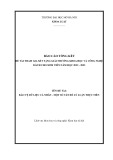
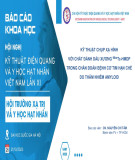

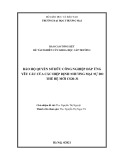
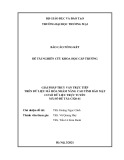

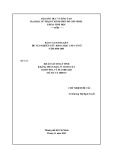
![Vaccine và ứng dụng: Bài tiểu luận [chuẩn SEO]](https://cdn.tailieu.vn/images/document/thumbnail/2016/20160519/3008140018/135x160/652005293.jpg)

